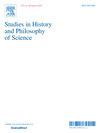透过凸面镜:时空理论中动力学和时间几何之间联系的亥姆霍兹式课程。
IF 1.8
2区 哲学
Q1 HISTORY & PHILOSOPHY OF SCIENCE
引用次数: 0
摘要
在过去的二十年里,时空理论哲学中动力论观点的兴起激发了关于时间几何结构和动力学之间联系方式的讨论。几何学家认为时间几何学决定并解释了动力学,而动力学家则相反。双方都认为,争论中的解释之箭涉及到一种要素的根本性和优先性的主张。我对这种假设提出了挑战,并提出了第三种理解这种联系的方法。从赫尔曼·冯·亥姆霍兹和大卫·希尔伯特关于几何基础的观点中吸取教训,我认为,在时空理论中,时间几何和动力学是不可分割地相互关联的对立物,因此,无论所谓的箭头的方向如何,基本解释和优先级的主张都是误解。时空理论中时间几何学和动力学之间的联系是用双向箭头来正确理解的,而不是用基本解释的单向箭头。本文章由计算机程序翻译,如有差异,请以英文原文为准。
Through the convex Looking Glass: A Helmholtzian lesson for the connection between dynamics and chronogeometry in spacetime theories
Over the last two decades, the rise of the dynamicist view in the philosophy of spacetime theories has motivated a discussion about the way in which chronogeometric structure and dynamics are connected. Geometricists defend that chronogeometry determines and explains dynamics, whereas dynamicists state that it is the other way around. Both parties assume that the arrow of explanation at issue involves a claim of fundamentality and priority of one of the elements over the other. I challenge this assumption, and I propose a third way to understand the connection. Drawing a lesson from Herman von Helmholtz's and David Hilbert's views on the foundations of geometry, I argue that in spacetime theories chronogeometry and dynamics are inextricably interconnected counterparts, so claims of fundamental explanation and priority, regardless of the direction of the alleged arrow, are misconceptions. The link between chronogeometry and dynamics in spacetime theories is properly understood in terms of a bidirectional arrow, not in terms of a unidirectional arrow of fundamental explanation.
求助全文
通过发布文献求助,成功后即可免费获取论文全文。
去求助
来源期刊

Studies in History and Philosophy of Science
管理科学-科学史与科学哲学
CiteScore
2.50
自引率
10.00%
发文量
166
审稿时长
6.6 weeks
期刊介绍:
Studies in History and Philosophy of Science is devoted to the integrated study of the history, philosophy and sociology of the sciences. The editors encourage contributions both in the long-established areas of the history of the sciences and the philosophy of the sciences and in the topical areas of historiography of the sciences, the sciences in relation to gender, culture and society and the sciences in relation to arts. The Journal is international in scope and content and publishes papers from a wide range of countries and cultural traditions.
 求助内容:
求助内容: 应助结果提醒方式:
应助结果提醒方式:


